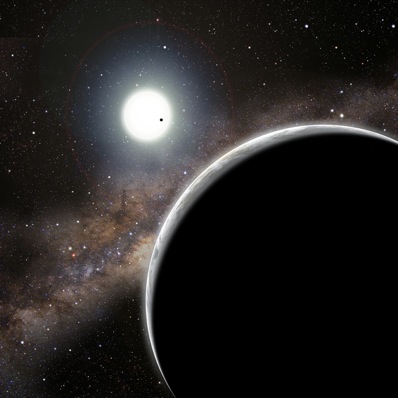


|

|
 |
|
Kepler leaves unseen exoplanet nowhere to hide KEITH COOPER ASTRONOMY NOW Posted: 12 September 2011 Since 1995 astronomers have been discovering exoplanets that they cannot see by watching the way their gravity tugs on their parent stars, but now Kepler scientists are going one step better by discovering planets that tug on other planets. NASA’s Kepler spacecraft, launched in 2009, is designed to stare at a patch of space in the direction of the constellations of Lyra and Cygnus, and monitor for changes in the brightness of around 100,000 stars that may indicate a planet has passed in front of them, marginally dimming their light. The passes of exoplanets in front of their stars are called transits, and one such world discovered by this technique is Kepler-19b, a ‘super-Earth’ twice the size of our planet in a 29.6 million kilometre orbit around a magnitude +12 star 650 light years away in Lyra. As a consequence of its proximity to its star, Kepler-19b’s surface roasts at 480 degrees Celsius.  An artist’s impression of Kepler-19c, with fellow planet Kepler-19b transiting its star in the background. Image: David A Aguilar (CfA). Kepler-19b, however, has a problem with punctuality. It should transit its star every nine days and seven hours, but every 300 days it transits five minutes late, then 300 days later it transits five minutes early, then five minutes late again and so on. In a research paper published in The Astrophysical Journal, a team led by Sarah Ballard of the Harvard–Smithsonian Center for Astrophysics show how this failure in time-keeping is caused by the gravitational influence of an unseen planet designated Kepler-19c. In principle, this is nothing new. In our Solar System the orbits of the planets are shaped partly with the help of the other planets, and a perturbation in Uranus’ orbit led astronomers to suspect the existence of Neptune, which was finally discovered in 1846. When it comes to exoplanets, Transit Timing Variations (TTV) were shown to be a viable method for detecting other planets in the case of Kepler-9b and 9c last year, when two planets (which were both seen transiting) exhibited regular discrepancies in the timing of their transits (see our news story here). Claims for the discovery of planets via TTV have since come thick and fast, with cases to be made for the WASP-3, WASP-5 and WASP-10 systems, but they lack the definitive proof that Ballard’s team have for Kepler-19. Because of Kepler’s continuous monitoring of Kepler-19, there are dozens of recorded transits, whereas in the case of the WASP planets (discovered by the British-led SuperWASP – Wide Angle Search for Planets – project, which utilises off-the-shelf CCD cameras on small observatories in South Africa and La Palma in the Canaries) transits observed years apart are stitched together to provide an incomplete picture. Not that the picture for Kepler-19c is complete yet. We know the planet is there, but its size, mass and orbit remain mysteries. It is not seen to transit, which leaves two possibilities: either its orbit is inclined to the plane of the Kepler-19 system so that it doesn’t pass in front of the star from our viewing angle, or that it does transit but is too small to be detected. Kepler was designed to detect transiting planets down to just a little smaller than Earth, but a new report by Ron Gilliland of the Space Telescope Science Institute in Baltimore, USA, to also be published in The Astrophysical Journal, suggests that detecting the smallest worlds is going to be more difficult because the natural ‘jitter’ in a star’s brightness has turned out to be higher than expected, meaning that the signals of small Earth- and Mars-sized worlds could end up being drowned out by noise. Help could arrive next year in the form of reinforcements: HARPS North, which is being developed by Harvard and Geneva Observatory as a sister instrument to the famed HARPS (High Accuracy Radial velocity Planet Searcher) at the European Southern Observatory in Chile. HARPS is designed to detect the slight wobble of a star induced by the gravity of an orbiting planet. For Earth-mass planets, this wobble can be as slow as walking speed, but HARPS North is sensitive enough to pick out this signal from Doppler shifts in the star’s light, and also disentangle it to see if there are more two planets present in the Kepler-19 system. HARPS North would also be able to measure the mass of Kepler-19c based on the size of the wobble. “I do believe that the [Kepler] mission will ultimately identify dozens of worlds using the TTV method,” Ballard tells Astronomy Now. “In some cases, TTVs will be observed in systems for which multiple bodies transit, and in other cases they will be observed in cases of seemingly singleton planets, which are clearly not alone after all. Kepler-19 is only the first of many in the latter category, I think. Indeed, it’s possible that there are more than two planets in the Kepler-19 system, which is very exciting.” TTV has also been mooted by David Kipping of Harvard as a possible technique for discovering moons around exoplanets, but the required sensitivity has not yet been shown possible with Kepler. To solve puzzles like exomoons, Kepler-19 and to get around the increased jitter problem, it may be necessary to extend the Kepler mission to at least eight years, reports Gilliland, but there are fears that the swollen and ever increasing budget of the James Webb Space Telescope (see our report here for more) could take money away from other science programmes such as Kepler, curtailing its mission beyond its original three-and-a-half year plan. |
|
|
|
|